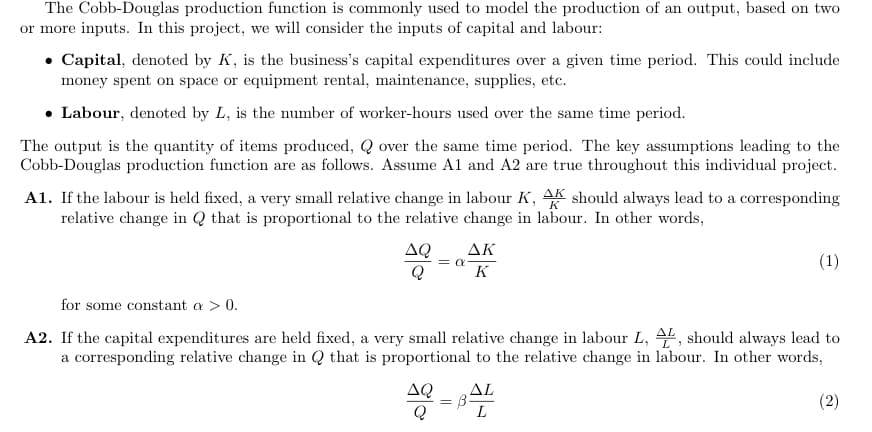The Cobb-Douglas production function is commonly used to model the production of an output, based on two or more inputs. In this project, we will consider the inputs of capital and labour: • Capital, denoted by K, is the business's capital expenditures over a given time period. This could include money spent on space or equipment rental, maintenance, supplies, etc. • Labour, denoted by L, is the number of worker-hours used over the same time period. The output is the quantity of items produced, Q over the same time period. The key assumptions leading to the Cobb-Douglas production function are as follows. Assume Al and A2 are true throughout this individual project. A1. If the labour is held fixed, a very small relative change in labour K, AK should always lead to a corresponding relative change in Q that is proportional to the relative change in labour. In other words, AQ AK = a K (1) for some constant a > 0. A2. If the capital expenditures are held fixed, a very small relative change in labour L, 4, should always lead to a corresponding relative change in Q that is proportional to the relative change in labour. In other words, ΔL AQ Q (2)
The Cobb-Douglas production function is commonly used to model the production of an output, based on two or more inputs. In this project, we will consider the inputs of capital and labour: • Capital, denoted by K, is the business's capital expenditures over a given time period. This could include money spent on space or equipment rental, maintenance, supplies, etc. • Labour, denoted by L, is the number of worker-hours used over the same time period. The output is the quantity of items produced, Q over the same time period. The key assumptions leading to the Cobb-Douglas production function are as follows. Assume Al and A2 are true throughout this individual project. A1. If the labour is held fixed, a very small relative change in labour K, AK should always lead to a corresponding relative change in Q that is proportional to the relative change in labour. In other words, AQ AK = a K (1) for some constant a > 0. A2. If the capital expenditures are held fixed, a very small relative change in labour L, 4, should always lead to a corresponding relative change in Q that is proportional to the relative change in labour. In other words, ΔL AQ Q (2)
Chapter11: Profit Maximization
Section: Chapter Questions
Problem 11.14P
Related questions
Question

Transcribed Image Text:The Cobb-Douglas production function is commonly used to model the production of an output, based on two
or more inputs. In this project, we will consider the inputs of capital and labour:
• Capital, denoted by K, is the business's capital expenditures over a given time period. This could include
money spent on space or equipment rental, maintenance, supplies, etc.
• Labour, denoted by L, is the number of worker-hours used over the same time period.
The output is the quantity of items produced, Q over the same time period. The key assumptions leading to the
Cobb-Douglas production function are as follows. Assume A1 and A2 are true throughout this individual project.
A1. If the labour is held fixed, a very small relative change in labour K, AK should always lead to a corresponding
relative change in Q that is proportional to the relative change in labour. In other words,
AK
AQ
Q
(1)
= CE
K
for some constant a > 0.
A2. If the capital expenditures are held fixed, a very small relative change in labour L, 4", should always lead to
a corresponding relative change in Q that is proportional to the relative change in labour. In other words,
AQ
AL
(2)
L

Transcribed Image Text:3. Assume that the capital K for a business is held fixed; consider the production Q to be a function of L only.
(a) Use equation A2 to find a formula for in terms of Q and L. (Let AL be infinitesimally small.)
dL
Expert Solution
This question has been solved!
Explore an expertly crafted, step-by-step solution for a thorough understanding of key concepts.
This is a popular solution!
Trending now
This is a popular solution!
Step by step
Solved in 2 steps

Knowledge Booster
Learn more about
Need a deep-dive on the concept behind this application? Look no further. Learn more about this topic, economics and related others by exploring similar questions and additional content below.Recommended textbooks for you


Managerial Economics: Applications, Strategies an…
Economics
ISBN:
9781305506381
Author:
James R. McGuigan, R. Charles Moyer, Frederick H.deB. Harris
Publisher:
Cengage Learning

Microeconomics: Principles & Policy
Economics
ISBN:
9781337794992
Author:
William J. Baumol, Alan S. Blinder, John L. Solow
Publisher:
Cengage Learning


Managerial Economics: Applications, Strategies an…
Economics
ISBN:
9781305506381
Author:
James R. McGuigan, R. Charles Moyer, Frederick H.deB. Harris
Publisher:
Cengage Learning

Microeconomics: Principles & Policy
Economics
ISBN:
9781337794992
Author:
William J. Baumol, Alan S. Blinder, John L. Solow
Publisher:
Cengage Learning


